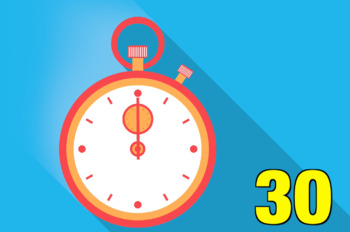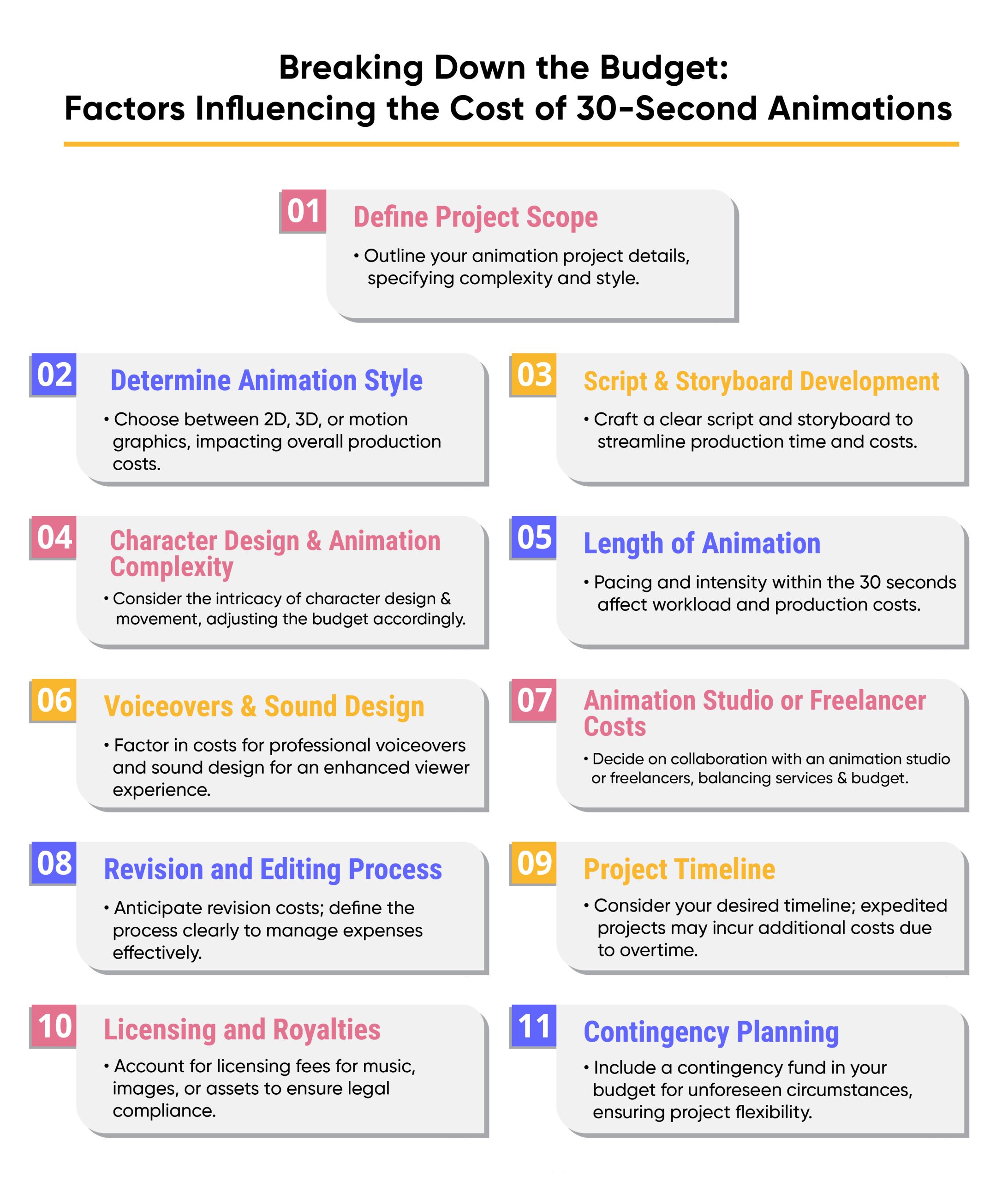How Much Does a 30 Second Animation Cost?

Introduction:
Animation has become an integral part of various industries, from entertainment to marketing, allowing businesses to convey complex messages in an engaging and visually appealing manner. However, the question that often perplexes both creators and clients is, “How much does a 30 second animation cost?” In this comprehensive guide, we’ll discuss the factors influencing animation costs and explore the rates for animation projects per second.

Understanding Animation Cost per Second:
Understanding the difficulties of animated explainer video cost involves a nuanced exploration of various factors that significantly influence the final price. In this section, we will delve into the key elements that contribute to the cost of animation per second, shedding light on the complexities and considerations that clients and creators alike must navigate.
1. Complexity of Animation:
The intricacy of an animation piece plays a pivotal role in determining its overall cost. Simplistic 2D animations, characterized by basic movements and minimal detailing, typically incur lower costs compared to their 3D counterparts. As animations become more complex, involving intricate designs and advanced visual effects, production costs naturally escalate.
2. Type of Animation:
Distinct animation styles come with distinct price tags. The meticulous frame-by-frame nature of stop-motion animation, for example, renders it more time-consuming and, consequently, more expensive than traditional 2D or 3D animation. Each style demands a unique set of skills and resources, contributing to the overall project cost.
3. Quality of Animation:
The quality of an animation, defined by factors such as realistic movements, textures, and lighting, directly impacts the cost. Achieving high-quality animations demands more time, expertise, and often, specialized tools or software. Clients are tasked with striking a balance between their budget constraints and the desired level of animation quality.
4. Storyboarding and Scripting:
The pre-production phase, encompassing tasks such as storyboarding and scripting, holds a substantial weight in the overall cost estimation. A meticulously crafted script and storyboard lay the foundation for a successful animation project, ensuring that the final product aligns seamlessly with the client’s expectations.
5. Voiceovers and Sound Design:
The inclusion of voiceovers and sound effects serves to enhance the viewer experience but also adds to the overall cost. Hiring professional voice actors and investing in high-quality sound design are essential components that contribute to the expenses. Clients need to consider these elements when gauging the overall cost of their animation project.
Animation Cost per Second Pricing Models:
Exploring the diverse pricing models for animation projects, particularly in the context of cost per second, is crucial for clients seeking clarity and budget predictability. Let’s dissect the three primary pricing models employed by animation studios, shedding light on their distinct features and suitability for various project dynamics.
1. Hourly Rates:
The hourly rate model hinges on charging clients based on the time invested in the animation project. This model proves beneficial for projects with evolving requirements where the scope may shift during the production phase. Clients pay for the actual hours spent on tasks, providing a flexible approach to pricing.
2. Fixed Project Rates:
Fixed project rates involve charging clients a predetermined, lump-sum amount for the entire animation project. This model offers transparency from the project’s initiation, enabling clients to establish a clear budget without the uncertainties of hourly billing. It is particularly suitable for well-defined projects with minimal anticipated changes.
3. Per-Second Pricing:
Per-second pricing is a prevalent model for animations, especially for shorter clips like 30-second sequences. Under this model, animation studios establish an animation per second price, providing clients with a straightforward method of estimating costs based on the desired duration of their project. This approach aligns well with the specific requirements of short-form content.
Rates for Animation Projects per Second:
Diving into the specifics of animation per second price necessitates a detailed exploration of the rates associated with varying animation styles. In this section, we’ll break down the pricing structures for 2D animation, 3D animation, and stop-motion animation, offering clients valuable insights into what to expect when budgeting for their projects.
1. 2D Animation:
- Simple 2D Animation: Typically falls within the range of $500 to $1,500 per second.
- Moderate Complexity: Ranges from $1,500 to $3,000 per second.
- Complex 2D Animation: Generally starts from $3,000 per second and can go higher.
2. 3D Animation:
- Basic 3D Animation: Falls within the range of $1,000 to $3,000 per second.
- Moderate Complexity: Ranges from $3,000 to $6,000 per second.
- Advanced 3D Animation: Generally starts from $6,000 per second and can exceed this baseline.
3. Stop-Motion Animation:
- Basic Stop-Motion: Typically falls within the range of $2,000 to $4,000 per second.
- Moderate Complexity: Ranges from $4,000 to $8,000 per second.
- High-End Stop-Motion: Generally starts from $8,000 per second and can go higher.
Understanding these tiered pricing structures provides clients with a benchmark for estimating costs based on their animation project’s complexity and desired quality. While these figures offer a general overview, it’s essential to recognize that additional factors, such as project-specific requirements, tight timelines, or the need for revisions, can influence the overall cost.
Clients venturing into the animation realm should view these rates as guides, allowing flexibility for negotiations based on project intricacies and studio policies. Moreover, transparent communication with animation studios regarding budget constraints and project expectations can facilitate a smoother collaboration and ensure the alignment of creative aspirations with financial realities.
Post-Production Cost Analysis
Animation, while primarily a creative endeavor, often undergoes a meticulous post-production phase, which is a key factor when determining how much does it cost to hire an animation studio. This stage involves fine-tuning the animation, incorporating visual enhancements, and ensuring a seamless, polished product. Understanding the nuances of post-production costs is crucial for clients aiming to manage their budgets effectively.
Post-Production Components:
Post-production encompasses various elements that contribute to the overall cost of an animation project:
Color Grading:
Color grading involves adjusting the color tones and enhancing the visual appeal of the animation. The complexity of the desired color palette and the duration of the animation can impact the cost.
Special Effects:
Incorporating special effects, such as particle simulations or dynamic lighting, can elevate the visual impact of the animation. However, these effects often require additional time and resources, influencing the overall cost.
Editing and Transitions:
The final editing phase involves refining transitions between scenes, ensuring a smooth flow. Complex transitions or intricate editing requirements may contribute to higher post-production costs.
Sound Design and Mixing:
Enhancing the viewer experience involves meticulous sound design and mixing. Professional-grade sound effects, music integration, and voiceover adjustments contribute to the auditory appeal but also add to the overall cost.
Rendering Time:
Rendering, the process of generating the final images or frames, is a resource-intensive task. Longer animations or those with intricate details may require extended rendering times, affecting both time and cost considerations.
Optimizing Post-Production Costs:
While post-production adds value to the animation, clients can implement strategies to optimize animation studio cost without compromising quality:
Clear Communication:
Establishing clear communication with the animation studio regarding post-production expectations can prevent misunderstandings. Clearly articulate your vision for color grading, effects, and editing to align with budget constraints.
Efficient Editing:
Streamlining the editing process by providing precise feedback and consolidating revisions can contribute to cost efficiency. Clearly define the desired transitions and editing style to minimize unnecessary iterations.
Strategic Sound Design Choices:
Collaborate with the studio to make strategic sound design choices that align with your budget. Prioritize essential elements that enhance the narrative while avoiding excessive or unnecessary sound complexities.
Render Farm Utilization:
Animation studios often use render farms to expedite rendering processes. Discussing render farm utilization with the studio can optimize rendering time, potentially reducing costs associated with extended rendering periods.
The ROI of Animation: Understanding the Long-Term Benefits Beyond the 30 Seconds
| Step | Action |
| 1. Define Objectives | Clarify animation goals, e.g., brand awareness or sales, for effective ROI evaluation. |
| 2. Craft a Compelling Story | Ensure the animation consistently communicates brand messages for lasting impact. |
| 3. Plan Strategic Distribution | Distribute the animation strategically across channels (websites, social media) for extended reach. |
| 4. Integrate Across Channels | Integrate animation into various marketing channels to reinforce brand identity. |
| 5. Monitor Analytics | Track performance beyond immediate metrics; analyze viewer retention, social shares, and comments over time. |
| 6. Repurpose Content | Extend the animation’s life by repurposing it into different formats for diverse platforms. |
| 7. Gather User Feedback | Encourage audience feedback to understand perception and continuously refine based on responses. |
| 8. Measure Conversions | Assess the animation’s impact on lead generation, customer acquisition, and overall revenue. |
| 9. Adapt and Evolve | Regularly update the animation to stay relevant amidst changing market dynamics and audience preferences. |
| 10. Benchmark and Compare | Compare the animation’s performance against industry standards and competitors for strategic insights. |
Final Words For How Much Does a 30 Second Animation Cost
Determining how much does a 30 second animation costs involves considering various factors, including the complexity, type, and quality of the animation. Collaborating with a studio that offers both animation and video editing services ensures a seamless production process, enabling clients to make informed decisions that align with their budget and project requirements.
Remember, while cost is a crucial factor, the quality of the animation ultimately determines its effectiveness in conveying the desired message to the audience.
FAQs
Q 1: Can I negotiate animation prices with a studio?
Yes, many animation studios are open to negotiations, especially for long-term projects or if you're bundling multiple services together.
Q 2: What factors can cause variations in animation pricing?
Factors such as project urgency, revisions, and additional services like voiceovers or sound design can lead to variations in animation costs.
Q 3: How can I ensure the animation stays within my budget?
Clearly communicate your budget constraints with the animation studio from the beginning. Additionally, having a well-defined project scope can help prevent unexpected costs.
Q 4: Are there any cost-saving tips for animation projects?
Consider simplifying the animation style, limiting revisions, and providing clear feedback during the production process to streamline the project and reduce costs.
Q 5: What should I look for in an animation studio to ensure quality work?
Look for studios with a strong portfolio, positive client reviews, and experience in your specific industry. A collaborative and transparent communication process is also crucial for a successful partnership.
Q 6: How much does it cost to hire an animation studio?
The cost to hire an animation studio varies widely depending on the project's complexity, style (2D or 3D), and additional services required. Simple animations might start around $1,000 per minute, while more complex projects can exceed $10,000 per minute. Discussing your specific needs with the studio will provide a more accurate estimate.
Q 7: How many frames in a 30 second animation?
A 30 second animation typically contains 720 frames if produced at 24 frames per second (fps), or 900 frames if produced at 30 fps. The frame rate impacts the smoothness and quality of the animation.










